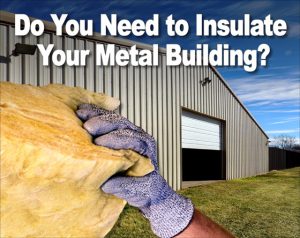Three Main Reasons to Insulate a Prefab Steel Building
When buying a new prefabricated steel building kit, how do you know if you need metal building insulation?
It is really pretty simple.
 There are three reasons you should consider insulating your structure: comfort, cost, and condensation.
There are three reasons you should consider insulating your structure: comfort, cost, and condensation.
Metal Building Insulation for Comfort
Think about the end use for your new steel structure. If you or others will be spending considerable time in it, you will want to be comfortable, year in and year out. Insulation keeps sizzling summer heat and frigid winter chill at bay.
Steel Building Insulation Cuts Costs
All climate-controlled structures definitely call for metal building insulation— and not just any insulation, but a high-quality insulation system.
The deep wall cavities of a commercial-grade steel building provide the perfect space for thick, heavy-duty insulation. Not only can you insulate easily, you can also choose to insulate well.
For example, RHINO’s Pro-Value Insulation Package saves big bucks on heating and cooling, cutting utility bills in half!
Metal Building Insulation Fights Condensation
When the temperatures inside and outside of an uninsulated building vary wildly, condensation forms. Over time, condensation causes multiple headaches for building owners, including:
- Funky, musty odors
- Poor indoor air quality
- Increased insect infestations
- Drips on unprotected contents of the building
- Rust and corrosion of the building, reducing its value
Well-insulated and well-ventilated steel buildings stop condensation in its tracks.
Steel Building Insulation with RHINO
Is it any wonder that over 67% of all RHINO’s orders last year included metal building insulation? RHINO’s Pro-Value Insulation delivers a comfortable, condensation-free interior, while cutting heating and cooling costs by 50%.
Our insulation system also acts as a sound buffer for a much quieter interior.
The Pro-Value System includes:
- Thick fiberglass batt insulation, to fill wall cavities without compressing the insulation, providing the most effective insulating properties
- A washable vapor barrier fabric that is 300% stronger than the flimsy vinyl barriers common with other metal building companies
- Steel retainer straps that hold the fabric and insulation in place
- A second layer of insulation that provides a thermal break, increasing the overall R-value of the insulation system
Call us today and learn more about the RHINO Difference in steel buildings. Speak to one of our metal building specialists at 940.383.9566.
Try us just once, and you too will be hooked on RHINO Steel Building Systems.
